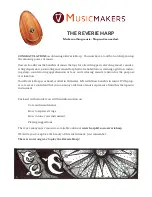
Just play.
Seriously. Put this paper down and go play your harp for 5 minutes. See how easy that was?
Many people have a very loud inner voice that is trying to tell them they can’t play an instru-
ment. Nothing will still that voice faster than just playing.
Strum and Pluck.
Strum all the strings at once and while the strings are still ringing, pluck a series of single
notes at random. Notice how all the strings sounding from the first strum provide a nice
foundation for the individual notes. Experiment with this idea.
Explore Rhythm.
Pluck strings at random until you stumble upon a rhythmic pattern that you like. Pay more
attention to the rhythm than the notes you are playing remembering that any note will sound
OK. Notice if the rhythm wants to change over time. Let it change. Just be with the rhythm
and follow wherever it goes.
Explore Melody.
Sit quietly and pluck strings randomly until you hear a phrase or combination of notes that
sounds like a pleasing melody. Try to repeat what you just played. See how the melody wants
to be and how you respond to it. See how it changes over time. Maybe you change it on pur-
pose or maybe you hit a “wrong note” but feel like the “wrong note” is better...
Mix it up.
Combine any of these ideas together. Find a melody and then change the rhythm. Find a
rhythm and then change the melody. Add a full strum into a melody or rhythm.
Use a Songsheet.
If you want to play a familar melody on the Reverie Harp you can use some of the included
songsheets. See our directions for Using Songsheets on the other side of this sheet.
Playing Suggestions
The Reverie Harp




















